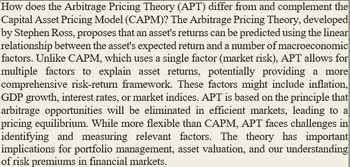
Financial Management: Theory & Practice
16th Edition
ISBN: 9781337909730
Author: Brigham
Publisher: Cengage
expand_more
expand_more
format_list_bulleted
Question
thumb_up100%

Transcribed Image Text:How does the Arbitrage Pricing Theory (APT) differ from and complement the
Capital Asset Pricing Model (CAPM)? The Arbitrage Pricing Theory, developed
by Stephen Ross, proposes that an asset's returns can be predicted using the linear
relationship between the asset's expected return and a number of macroeconomic
factors. Unlike CAPM, which uses a single factor (market risk), APT allows for
multiple factors to explain asset returns, potentially providing a more
comprehensive risk-return framework. These factors might include inflation,
GDP growth, interest rates, or market indices. APT is based on the principle that
arbitrage opportunities will be eliminated in efficient markets, leading to a
pricing equilibrium. While more flexible than CAPM, APT faces challenges in
identifying and measuring relevant factors. The theory has important
implications for portfolio management, asset valuation, and our understanding
of risk premiums in financial markets.
Expert Solution
This question has been solved!
Explore an expertly crafted, step-by-step solution for a thorough understanding of key concepts.
Step by stepSolved in 2 steps

Knowledge Booster
Similar questions
- The Capital Asset Pricing Model (CAPM) asserts that an asset’s expected return is equal to the risk-free rate plus a risk premium for: a. Volatility b. Systematic risk c. Non-systematic risk d. Diversification e. Marginal utility of consumptionarrow_forwardThis is a generalized framework for analyzing the relationship between risk and return: a. capital asset pricing model b. diversification theory c. capital market line d. arbitrage pricing theoryarrow_forwardWhat does beta measure?arrow_forward
- What are the main differences between the Capital Asset Pricing Model (CAPM) and the Arbitrage Pricing Theory (APT) model? What are each model’s underlying assumptions, strengths and weaknesses?arrow_forwardExplain the relationship between JENSEN's alpha and the security marketline of the Capital asset pricing model (CAPM).arrow_forwardCarefully explain the Arbitrage Pricing Theory (APT). What is the main assumption the APT is built on? (b) With regard to market efficiency, what is meant by the term "anomaly"? Give two examples of market anomalies and explain why each is considered as an anomaly.arrow_forward
- In contrast to the capital asset pricing model, arbitrage pricing theory:a. Requires that markets be in equilibrium.b. Uses risk premiums based on micro variables.c. Specifies the number and identifies specific factors that determine expected returns.d. Does not require the restrictive assumptions concerning the market portfolio.arrow_forwardThe feature of the general version of the arbitrage pricing theory (APT) that offers the greatest potential advantage over the simple CAPM is the:a. Identification of anticipated changes in production, inflation, and term structure of interest rates as key factors explaining the risk–return relationship.b. Superior measurement of the risk-free rate of return over historical time periods.c. Variability of coefficients of sensitivity to the APT factors for a given asset over time.d. Use of several factors instead of a single market index to explain the risk–return relationship.arrow_forwardWhat is the Capital Asset Pricing Model (CAPM)?What are some of its key assumptions? Has itbeen empirically verified? What is the role of theSecurity Market Line in the CAPM?arrow_forward
- Discuss the Capital Asset Pricing Model (CAPM) and the Arbitrage Pricing Model (APM) of Roll and Ross. What are the main differences between these two models?arrow_forwardAn investor takes as large a position as possible when an equilibrium price relationship is violated. This is an example of:a. A dominance argument.b. The mean-variance efficient frontier.c. Arbitrage activity.d. The capital asset pricing model.arrow_forwardThe general arbitrage pricing theory (APT) differs from thesingle-factor capital asset pricing model (CAPM) because theAPT: A. Places more emphasis on market risk.B. Minimizes the importance of diversification.C. Recognizes multiple unsystematic risk factors.D. Recognizes multiple systematic risk factors.arrow_forward
arrow_back_ios
SEE MORE QUESTIONS
arrow_forward_ios
Recommended textbooks for you

 Intermediate Financial Management (MindTap Course...FinanceISBN:9781337395083Author:Eugene F. Brigham, Phillip R. DavesPublisher:Cengage Learning
Intermediate Financial Management (MindTap Course...FinanceISBN:9781337395083Author:Eugene F. Brigham, Phillip R. DavesPublisher:Cengage Learning Financial Reporting, Financial Statement Analysis...FinanceISBN:9781285190907Author:James M. Wahlen, Stephen P. Baginski, Mark BradshawPublisher:Cengage Learning
Financial Reporting, Financial Statement Analysis...FinanceISBN:9781285190907Author:James M. Wahlen, Stephen P. Baginski, Mark BradshawPublisher:Cengage Learning


Intermediate Financial Management (MindTap Course...
Finance
ISBN:9781337395083
Author:Eugene F. Brigham, Phillip R. Daves
Publisher:Cengage Learning

Financial Reporting, Financial Statement Analysis...
Finance
ISBN:9781285190907
Author:James M. Wahlen, Stephen P. Baginski, Mark Bradshaw
Publisher:Cengage Learning